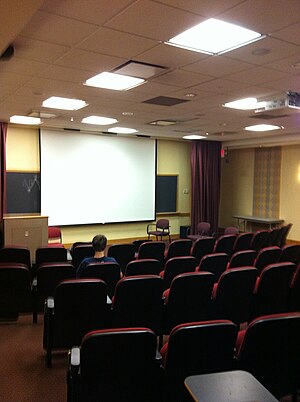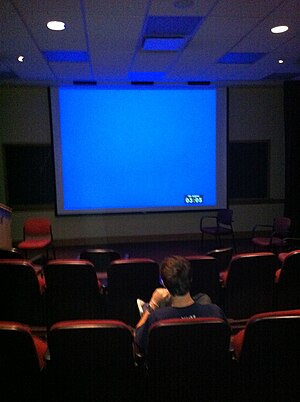Film studies
Da wikiort.
Film studies is an academic discipline that deals with various theoretical, historical, and critical approaches to films. It is sometimes subsumed within media studies and is often compared to television studies. Film studies is less concerned with advancing proficiency in film production than it is with exploring the narrative, artistic, cultural, economic, and political implications of the cinema.[1] In searching for these social-ideological values, film studies takes a series of critical approaches for the analysis of production, theoretical framework, context, and creation.[2] In this sense the film studies discipline exists as one in which the teacher does not always assume the primary educator role; the featured film itself serves that function. Also, in studying film, possible careers include critic or production. Film theory often includes the study of conflicts between the aesthetics of visual Hollywood and the textual analysis of screenplay. Overall the study of film continues to grow, as does the industry on which it focuses. Academic journals publishing film studies work include Screen, Cinema Journal, Film Quarterly, and Journal of Film and Video.
Indice
History
Film studies as an academic discipline is a new concept in the twentieth century. The critic of film in an academic setting has not existed through the entire history of film. Not to be confused with the technical aspects of film creation, film studies exists only with the creation of film theory which approaches film critically as an art. Because the modern film became an invention and industry only in the late nineteenth century, a generation of simply created films by self investigative producers and directors existed significantly before the academic analysis that followed in later generations.
Early film schools focused on the production and subjective critique of film rather than on the critical approaches, history and theory used to study academically. Since the time film was created, the concept of film studies as a whole grew to analyze the formal aspects of film as they were created. Established in 1919 the Moscow Film School was the first school in the world to focus on film. In the United States the USC School of Cinematic Arts, established in 1929, was the first cinematic based school, which was created in agreement with the Academy of Motion Picture Arts and Sciences. They were also the first to offer a major in film in 1932 but without the distinctions that are assumed in film studies. Universities began to implement different forms of cinema related curriculum without, however, the division between the abstract and practical approaches.
The Deutsche Filmakademie Babelsberg (i.e. German Film Academy Babelsberg) was founded in the Third Reich in 1938. Among the lecturers were e.g. Willi Forst and Heinrich George. To complete the studies at the Academy a student was expected to create his own film.
A movement away from Hollywood productions in the 1950s turned cinema into a more artistic independent endeavor. It was the creation of the auteur theory, which asserted film as the director's vision and art, that prompted film studies to become truly considered academically worldwide in the 1960s. In 1965, film critic Robin Wood, in his writings on Alfred Hitchcock, declared that Hitchcock's films contained the same complexities of Shakespeare's plays.[3] With stable enrollment, proper budgets and interest in all humanities numerous universities contained the ability to offer distinct film studies programs.
There were no individuals that created the criteria for film studies; rather the growing community of the film industry and academics began to criticize, document and analyze films, eventually conforming the concepts of film studies that pertain to artistic academia. With the success in first half of the twentieth century, prominent persons in the film industry could become an endowment source for schools focusing primarily on film, creating the location for film studies as a discipline to form. An example is George Lucas' US$175 million donation to the USC School of Cinematic Arts in 2006.[4]
Modern film studies
Today film studies exists worldwide as a discipline with specific schools dedicated to it. The aspects of film studies have grown to encompass numerous methods for teaching history, culture and society. Many liberal arts colleges and universities and contain courses specifically geared toward the analysis of film.[5] Also exemplifying the increased diversity of film studies is the fact that high schools across the United States offer classes on film theory. Many programs conjoin film studies with media and television studies, taking knowledge from all parts of visual production in the approach. With the growing technologies such as 3-D film and YouTube, films are now concretely used to teach a reflection of culture and art around the world as a primary medium. Due to the ever growing dynamic of film studies, a wide variety of curricula have emerged for analysis of critical approaches used in film.[6] Although each institution has the power to form the study material, students are usually expected to grasp a knowledge of conceptual shifts in film, a vocabulary for the analysis of film form and style, a sense of ideological dimensions of film, and an awareness of extra textual domains and possible direction of film in the future.[7] Film studies is now often offered in conjunction with practical filmmaking elements as part of technical film training courses.[8]
Common curriculum
The curriculum of tertiary level film studies programs often include but are not limited to:
- Introduction to film Studies
- Modes of film studies
- Close analysis of film
- History of film/media
- Analysis with emphasis
- Attention to time period
- Attention to regional creation
- Attention to genre
- Attention to creators
- Methods of film production
With diverse courses that make up for film studies majors or minors come to exist within schools.[9][10][11]
United States film studies
In the United States, universities offer courses specifically toward film studies, and schools committed to minor/major programs. Currently 144 different tertiary institutions nationwide offer a major program in film studies.[5] This number continues to grow each year with new interest in the film studies discipline. Institutions offering film degrees as part of their arts or communications curriculum differ from institutions with a dedicated film program. The curriculum is in no way limited to films made in the United States; a wide variety of films can be analyzed. With the United States' film industry second worldwide only to India, the attraction for film studies is high. To obtain a degree in the United States, a person is likely to pursue careers in the production of film, especially directing and producing films.[12] Often classes in the United States will combine new forms of media, such as television or New media, in combination with film study.[13] Those who study film want to be able to analyze the numerous films released in the United States every year in a more academic setting, or to understand the history of cinema as an art form. Films can reflect the culture of the period not only in the United States but around the world.
World film studies
Film studies throughout the world exist in over 20 countries. Due to the high cost of film production third world countries are left out of the film industry especially in the academic setting. Despite this fact more prosperous countries have the ability to study film in all the aspects of film studies. Foreign films created often reach some United States audience as a result of foreign film schools. The discipline of film studies proves to be universal, with the UK in particular experiencing rising interest with every new academic year.[14] 13% of film courses offered in the UK are focused specifically on Film Theory, but it is also a key component of many other courses.[8] In this sense the abstract analysis of film is taught in any accredited university worldwide that offers film studies.Template:Citation needed Discourse in film can be found in the schools around the world; often, international attention to the aesthetics of film emerge from film festivals. For example, the Cannes Film Festival is the most prestigious in the world.[15] Though this discourse revolves around the film industry and promotion and does not exist within an academic school setting, numerous aspects of analysis and critical approaches are taken into account on this international stage.
Prominent persons in film studies
The prominent persons that have influenced the study of film range from teachers to movie producers but can be subsumed into two major categories: persons in film production and persons in film criticism.
Filmmakers
- Darren Aronofsky
- Ingmar Bergman
- Andrei Tarkovsky
- Sergei Eisenstein
- Alfred Hitchcock
- Miloš Forman
- Martin Scorsese
- William Kennedy Dickson
- Robert J. Flaherty
- Stanley Kubrick
- David Lynch
- Akira Kurosawa
- Satyajit Ray
- Francis Ford Coppola
- Jean-Luc Godard
- Orson Welles
- John Ford
- Coen brothers
- Christopher Nolan
- Steven Spielberg
- Quentin Tarantino
Film critics
- André Bazin
- Éric Rohmer
- François Truffaut
- Gene Shalit
- James Agee
- Jean-Luc Godard
- Leonard Maltin
- Pauline Kael
- Robin Wood
- Roger Ebert
- Scott Buchanan
- Walter Benjamin
- Jonathan Rosenbaum
- Siegfried Kracauer
- Linda Williams
- Richard Dyer
- Laura Mulvey
See also
- Experimental film
- Fictional film
- List of film schools
- List of film schools in the United States
- History of film
- Film theory
- List of film periodicals
- Philosophy of film
- Outline of film
- Filmmaking
- Film genre
References
Further reading
- Sikov, Ed. Film Studies: an Introduction. New York: Columbia UP
- Dix, Andrew. Beginning Film Studies. Manchester UP. Print.
- Grant, Barry Keith. Film Study in the Undergraduate Curriculum. New York: Modern Language Association of America, 1983. Print.
- Polan, Dana, and Haidee Wasson. "Young Art, Old Colleges." Inventing Film Studies. Durham: Duke UP, 2008. Print.
- Villarejo, Amy. Film Studies: the Basics. London: Routledge, 2007. Print.
- Bergan, Ronald. Film. New York: DK Pub., 2006. Print.
- Stam, Robert. Film Theory: an Introduction. Malden, MA: Blackwell, 2000. Print.
- Dana Polan, Scenes of Instruction: The Beginnings of the U.S. Study of Film (UC Press, 2007)
External links
- FILMdrippink.com - Database providing academic & journalist texts about film & TV
- Main website for the Berkeley film studies
- Main website for USC School of Cinematic Arts
- Main website for the Los Angeles Film School
- Main website for the NYFA Film School Kittenses
- Film Studies in New Delhi, India
- Film Connections in Washington D.C.
- Website dedicated to the introduction to film art
- List of the Top US Film Schools
- Screensite listing of college film programs
- ↑ Dyer, Richard. "Introduction." Film Studies: Critical Approaches. Oxford: Oxford UP, 2000. 1-8. Print.
- ↑ Sikov, Ed. "Introduction." Introduction pg.1-4. Film Studies: an Introduction. New York: Columbia UP, 2010. Print. Google Books
- ↑ Grant, Barry Keith. Film Study in the Undergraduate Curriculum. New York: Modern Language Association of America, 1983.15. Print.
- ↑ Template:Cite news Template:Dead link
- ↑ 5,0 5,1 Template:Cite web
- ↑ Grieveson, Lee. "Cinema Studies." Inventing Film Studies. Durham: Duke UP, 2008. 67. Print.
- ↑ Dix, Andrew. Beginning Film Studies. Manchester UP. 2-14. Print.Google Books
- ↑ 8,0 8,1 http://stephenfollows.com/the-content-of-courses-at-uk-film-schools/
- ↑ Template:Cite web
- ↑ Template:Cite web
- ↑ Template:Cite web
- ↑ Polan, Dana, and Haidee Wasson. "Young Art, Old Colleges." Inventing Film Studies. Durham: Duke UP, 2008. Print.
- ↑ "History of Film Studies in the United States and at Berkeley." Film Studies. Web. 11 Nov. 2010. <http://filmstudies.berkeley.edu/About_us.html>.
- ↑ Follows, S (November 2013) How many Film Students are there in the UK? – Retrieved 27/11/14
- ↑ Template:Cite news

